Search results for: 'For'
-
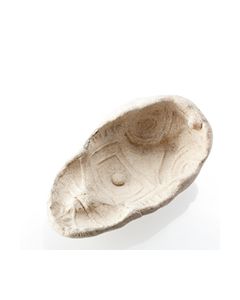 Maya-Kultur - Gussform für Fabelwesen
Maya-Kultur - Gussform für FabelwesenDie Form ergibt ein stilisiertes Tier oder ein Fabelwesen. Rückseite flach. Etwa 300 n. Chr. bis 900 n. Chr.
Price: on request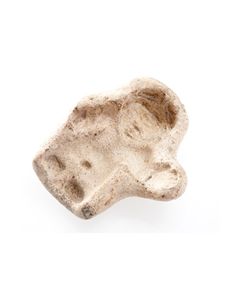 Maya-Kultur - Gussform für männliche Figur
Maya-Kultur - Gussform für männliche FigurForm ergibt eine gedrungene männliche Figur mit erhobener Hand und angedeutetem Phallus. Deutliche Gesichtszüge und Kopfbedeckung.
Price: on request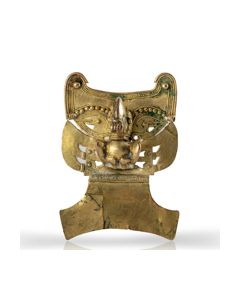 Gold figurine of an eagle from Colombia
Gold figurine of an eagle from ColombiaMagnificent example of the pre-Columbian Tairona culture, which produced the most impressive gold works of ancient America. In mythology, the eagle brought the seeds for one of the main crops, cassava. Made between 900 and 1550 AD.
€8,500 Gourd shaped bowl of the Chimú culture
Gourd shaped bowl of the Chimú cultureElegant bowl with shiny black surface. Precolumbian pottery of the 10th to 15th century.
Price: on request Jaguar vessel of the Guanacaste-Nicoya peoples
Jaguar vessel of the Guanacaste-Nicoya peoplesThe imposing vessel shows not just a jaguar but a transformed shaman in his animal form. It was made in Pre-Columbian Mesoamerica between 800 and 1200 AD and used for funeral purposes in the Guanacaste region.
Price: on request Pre-Columbian gold earrings from Colombia
Pre-Columbian gold earrings from ColombiaMatching pair of gold earrings from the Zenú culture. Dating to the 1st millennium. Elegant gold jewellery, once worn as earrings by the Zenú people.
€12,000 Large ceremonial knife of the Sican culture
Large ceremonial knife of the Sican cultureThe so-called Tumi was a weapon to cut the throats of humans and animals in ritual sacrifices. The knife certainly fulfilled an additional representative function in the afterlife. From the period of the Sican's cultural florescence during the 10th to 12th centuries AD.
Price: on request Ceremonial knife of the Sican culture
Ceremonial knife of the Sican cultureThe so-called Tumi was a weapon to cut the throats of humans and animals in ritual sacrifices. The knife certainly fulfilled an additional representative function in the afterlife. From the period of the Sican's cultural florescence during the 10th to 12th centuries AD.
Price: on request Small ceremonial knife of the Sican culture
Small ceremonial knife of the Sican cultureThe so-called Tumi was a weapon to cut the throats of humans and animals in ritual sacrifices. The knife certainly fulfilled an additional representative function in the afterlife. From the period of the Sican's cultural florescence during the 10th to 12th centuries AD.
Price: on request Huge ceremonial knife of the Sican culture
Huge ceremonial knife of the Sican cultureThe so-called Tumi was a weapon to cut the throats of humans and animals in ritual sacrifices. The knife certainly fulfilled an additional representative function in the afterlife. From the period of the Sican's cultural florescence during the 10th to 12th centuries AD.
€515 Ceremonial knife of the Sican culture
Ceremonial knife of the Sican cultureThe so-called Tumi was a weapon to cut the throats of humans and animals in ritual sacrifices. The Tumi certainly fulfilled an additional representative function in the afterlife. From the period of the Sican's cultural florescence during the 10th to 12th centuries AD.
Price: on request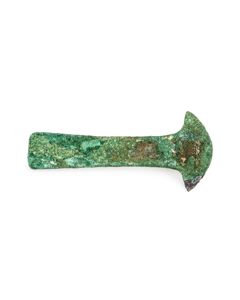 Ceremonial knife of the Sican culture
Ceremonial knife of the Sican cultureThe so-called Tumi was a weapon to cut the throats of humans and animals in ritual sacrifices. The knife certainly fulfilled an additional representative function in the afterlife. From the period of the Sican's cultural florescence during the 10th to 12th centuries AD.
Price: on request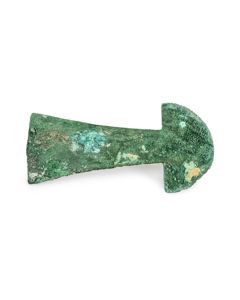 Large ceremonial knife of the Sican culture
Large ceremonial knife of the Sican cultureThe so-called Tumi was a weapon to cut the throats of humans and animals in ritual sacrifices. The knife certainly fulfilled an additional representative function in the afterlife. From the period of the Sican's cultural florescence during the 10th to 12th centuries AD.
€420 Gold figurine of a flute player from Panama
Gold figurine of a flute player from PanamaA fine gold work once worn as a pendant around the neck by an elite. The small male figure was made by a largely uniform Panamanian culture, right before the old crafts disappeared under the influence of the Spaniards.
€8,800 Pre-Columbian gold earrings from Colombia
Pre-Columbian gold earrings from ColombiaMatching pair of gold earrings from the Zenú culture. Dating to the 1st millennium. Impressive gold jewellery, once worn as earrings by the Zenú people.
€8,000 Pre-Columbian gold earrings from Colombia
Pre-Columbian gold earrings from ColombiaMatching pair of gold earrings from the Zenú culture. Dating to the 1st millennium. Impressive gold jewellery with highly stylized waterbirds. Once worn as earrings by the Zenú people.
€6,000 Stirrup vessel as a water bird
Stirrup vessel as a water birdPlastically shaped vessel from the Peruvian Chimú culture, showing a water bird. From the 15th century. With TL report from 1979.
€910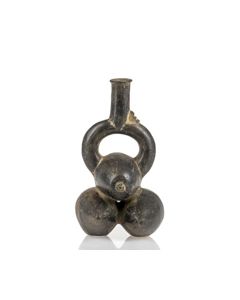 Stirrup vessel in the shape of cacao fruits
Stirrup vessel in the shape of cacao fruitsPlastically shaped vessel from the Peruvian Chimú culture. It embodies an important agricultural product of the pre-Columbian civilization of Chimor. With TL report from 1979. Part of a special exhibition from 2024 to 2025.
€1,600 Bowl of the Chancay culture
Bowl of the Chancay cultureFlat pottery bowl with abstract painting. The pre-Columbian art of the Chancay seems simple at first, but radiates an elegance that still seems modern today.
Price: on request Bowl of the Chancay culture
Bowl of the Chancay cultureThin-walled pottery bowl with abstract painting. The pre-Columbian art of the Chancay seems simple at first, but radiates an elegance that still seems modern today.
Price: on request Bowl of the Chancay culture
Bowl of the Chancay cultureFlat pottery bowl with abstract painting. The pre-Columbian art of the Chancay seems simple at first, but radiates an elegance that still seems modern today.
Price: on request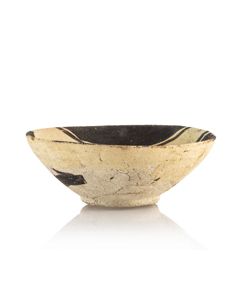 Bowl of the Chancay culture
Bowl of the Chancay cultureFlat pottery bowl with abstract painting on the inside. The pre-Columbian art of the Chancay seems simple at first, but radiates an elegance that still seems modern today.
Price: on request Bowl of the Chancay culture
Bowl of the Chancay cultureThin-walled pottery bowl with abstract painting. The pre-Columbian art of the Chancay seems simple at first, but radiates an elegance that still seems modern today.
Price: on request Bowl of the Chancay culture
Bowl of the Chancay cultureThin-walled pottery bowl with abstract painting and plastic animal head handles. The pre-Columbian art of the Chancay seems simple at first, but radiates an elegance that still seems modern today.
Price: on request Stirrup vessel in squash shape
Stirrup vessel in squash shapeGreat example of the intricately designed vessels of the Peruvian Chimú culture, decorated with a monkey and birds. The squash was an important fruit in the pre-Columbian Kingdom of Chimor.
€1,570

